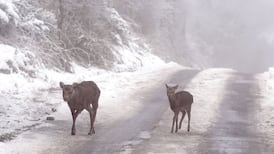A bird slightly bigger than a pigeon landed in the yard, walked up to within three feet of me and pecked at some food for a couple of minutes before flying away. It was white with small black spots, a black patch on its breast and white fur on its legs which covered half its claws.
Angela Duffy, Kells, Co Meath
It sounds astonishingly like a ptarmigan in winter plumage, common in Scotland but not here. How strange to find it in Co Meath. Perhaps someone is rearing them close by.
My neighbour found a huge caterpillar clinging to a potato stalk in his garden. It is about five inches long when it stretches, and almost an inch in diameter. It has eight segments, a stumpy little tail and a beautiful face. The two forward segments are a glorious yellow; each of the others has a wide blue V on a pale-green background pointing tailwards and containing multiple darkblue spots. It ignored a cabbage leaf but devoured a potato leaf. The moth or butterfly must be huge.
Robert Hayes, Cavan
It is the caterpillar of the death's head hawk-moth, which migrates in summer to Europe from Africa. It is the largest moth found in Europe and is a regular but not common visitor to these islands. Named for a skull-like pattern on its thorax, the moth is about 6 cm long with a wingspan of 11 cm.
Over the past few weeks we have noticed an unusual substance on several areas of our lawn. It is white-yellow and has the consistency and appearance of runny scrambled egg. It almost looks like it has been painted on to the blades of grass. Is some animal or bird regurgitating something?
Mike Burke, Mohill, Co Leitrim
The substance is a slime mould which is neither animal nor vegetable but has characteristics of both, being able to move in search of food by means of contractions. It lives on bacteria and fungi. The runny stage which you described develops into a darker coloured spore-containing fruit body. Warm humid weather can bring slime moulds, which are normally hidden in leaf mould or decaying matter, out into the open.
Edited by Michael Viney, who welcomes observations sent to him at Thallabawn, Carrowniskey PO, Westport, Co Mayo. e-mail: viney@anu.ie. Observations sent by e-mail should be accompanied by postal address as location is sometimes important to identification or behaviour.







